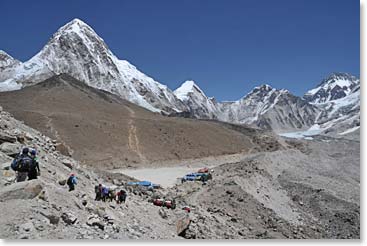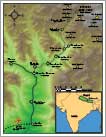
Leo Power Everest Marathon Dispatch
May 26, 2011 – Gorak Shep, Nepal, 5170m/16,962ft
This morning I had a "bucket shower" which was a cool experience, both literally and figuratively!
I've discovered today there will be approximately 100 people (half Nepalese and half foreigners) running the full Everest marathon on Sunday (a handful will run the 1/2 marathon).
There are seven Canadian entrants:
- Paul Nelson (Medicine Hat, AB)
- Michael Wood (Calgary)
- Todd Jalbert (Medicine Hat, AB)
- Karen Johansen (Calgary)
- Lorri Dobni (Saskatoon)
- Lynne Wawryk-Epp (Saskatoon)
- Leo Power
I've also discovered my race # is 50! The perfect age!
Pangboche at 4000m/13,123ft used to be the highest permanently occupied village in Nepal until tourism created a demand for villages like Lobuche and Gorak Shep, but these villages are generally not lived in year round. The Peruvians hold the unenviable record for highest permanent human habitation in a place called La Rinconada, an incredible elevation of 16,730 ft. above sea level.
Mount Everest continues to increase in height by approximately 5 cm a year. About 60 million years ago the Indian plate began moving northward and collided with the Eurasia plate driving the Indian subcontinent beneath Eurasia and it forced up the edge of Tibet and now we have the Himalaya! This collision is still happening today and continues to cause landslides, erosion and mountains that slowly climb upward. The Himalaya are among the youngest mountains in the world.
The Himalayan range is so high it prevents the monsoon rains from entering Tibet to the north.

The barren slopes of Kala Pattar and the blue roofed lodges
of Gorak Shep
The Sherpas are an ethnic group of Buddhists who have lived in northeast Nepal, in the Khumba Valley, 425 sq. miles below Mount Everest, for some 500 years after fleeing persecution in their homeland of Tibet by walking across the Himalaya. It's been quite the experience to live and trek with them and they have my total respect.
The Sherpas proudly use Sherpa as the last part of their name. They often add "Ang" to their name just as we would add Jr so a person by the name of Ang Nuru Sherpa would be called Nuru for short.
Sherpas were employed by the British expedition in 1921 during the first attempt to summit Everest and ever since they have rightfully played instrumental roles in the development of the tourism industry on their land.
It was the British who first brought potato growing to the Himalaya in the 19th century which helped ensure a more dependable form of subsistence farming and a lessening of a dependence on trading and this coupled with tourism radically transformed a previously impoverished people. Sherpas live throughout Nepal, but the most famous reside in the Khumbu region.
Sherpas, even today, carry everything on their backs or by Yak or wealthier Sherpas now hire others to do the heavy lifting. Sherpas normally always serve as the sirdar (trekking guide/boss) and hire the porters and sherpas- if the hires are not from the Sherpa clan then they are always differed by spelling sherpa with a lowercase s. The sherpas act as assistants to the sirdar. The cook is assisted by helpers, usually referred to as kitchen boys. Porters are the incredibly strong people who carry the bulk of the loads.
From my observations, the Sherpa people have benefitted enormously from tourism and on balance the changes have been positive. Sherpas are congenial, hard-working, and entrepreneurial. They appear to own most of the hundreds of lodges in the region and also appear to own a sizeable number of the trekking/expedition companies.
Naturally the impact has been to weaken the culture to some degree and the exodus of young people, many to the capital city of Kathmandu, is decried by many but the benefits of education, decent health facilities, running water, indoor plumbing, solar power, mini hydro projects, cell phones, satellite tv, cash, running water are welcomed by most, if not all.
Yet traditional ways appear to me to remain an important part of the Sherpas' lifestyle. Yaks are the beasts of burden and their utility to the Sherpas will ensure their existence far into the future. Yaks provide milk, cheese, butter, meat, fuel, building materials, clothes and transport. No mechanized transportation helps and a deep devotion to Buddhism and to their cherished monasteries also helps plus the Sherpas appear to have struck a reasonable balance between the benefits and necessity of modernity and a way of life that remains important to them and to that I say "good on them".
Tomorrow we complete our trek to base camp and I am admittedly bored with all the downtime I have experienced. So I look forward to seeing and experiencing base camp and to meeting more of my fellow marathoners. Tonight Gorak Shep is full of marathoners and plenty of anticipation and excitement in the air, so I'm caught up in the excitement of it all.
As much as I love the Sherpa and Nepalese people and their wonderful country I am missing family, friends, the NHL playoffs, a succulent striploin or ribeye at the Keg, newspapers and all things Canada.
Namaste,
– Leo Power


